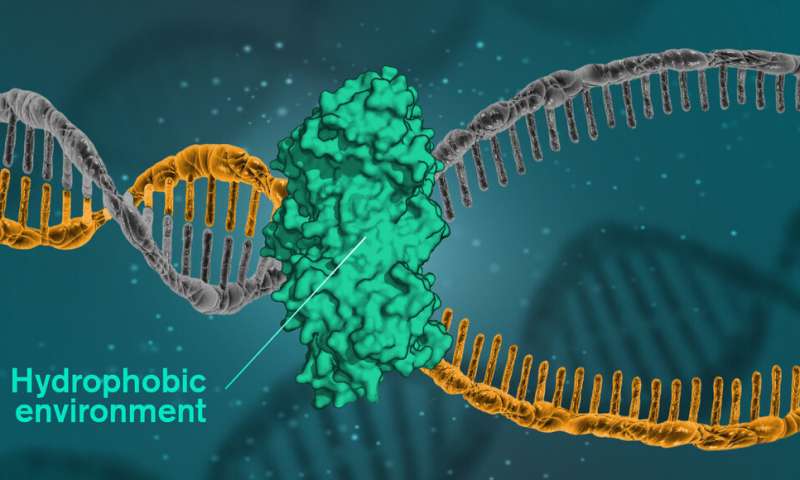
Researchers at Chalmers University of Technology, Sweden, have disproved the prevailing theory of how DNA binds itself. It is not, as is generally believed, hydrogen bonds which bind together the two sides of the DNA structure. Instead, water is the key. The discovery opens doors for new understanding in research in medicine and life sciences. The findings are published in PNAS.
DNA is constructed of two strands consisting of sugar molecules and phosphate groups. Between these two strands are nitrogen bases, the compounds that make up genes, with hydrogen bonds between them. Until now, it was commonly thought that those hydrogen bonds held the two strands together.
But now, researchers from Chalmers University of Technology show that the secret to DNA's helical structure may be that the molecules have a hydrophobic interior, in an environment consisting mainly of water. The environment is therefore hydrophilic, while the DNA molecules' nitrogen bases are hydrophobic, pushing away the surrounding water. When hydrophobic units are in a hydrophilic environment, they group together to minimize their exposure to the water.
The role of the hydrogen bonds, which were previously seen as crucial to holding DNA helixes together, appear to be more to do with sorting the base pairs so that they link together in the correct sequence. The discovery is crucial for understanding DNA's relationship with its environment.
"Cells want to protect their DNA, and not expose it to hydrophobic environments, which can sometimes contain harmful molecules," says Bobo Feng, one of the researchers behind the study. "But at the same time, the cells' DNA needs to open up in order to be used."
"We believe that the cell keeps its DNA in a water solution most of the time, but as soon as a cell wants to do something with its DNA, like read, copy or repair it, it exposes the DNA to a hydrophobic environment."
Reproduction, for example, involves the base pairs dissolving from one another and opening up. Enzymes then copy both sides of the helix to create new DNA. When it comes to repairing damaged DNA, the damaged areas are subjected to a hydrophobic environment, to be replaced. A catalytic protein creates the hydrophobic environment. This type of protein is central to all DNA repairs, meaning it could be the key to fighting many serious sicknesses.
Understanding these proteins could yield many new insights into fighting resistant bacteria, for example, or potentially curing cancer. Bacteria use a protein called RecA to repair their DNA, and the researchers believe their results could provide new insight into how this process works—potentially offering methods for stopping it and thereby killing the bacteria.
In human cells, the protein Rad51 repairs DNA and fixes mutated DNA sequences, which otherwise could lead to cancer. "To understand cancer, we need to understand how DNA repairs. To understand that, we first need to understand DNA itself," says Bobo Feng. "So far, we have not, because we believed that hydrogen bonds were what held it together. Now, we have shown that instead it is the hydrophobic forces which lie behind it. We have also shown that DNA behaves totally differently in a hydrophobic environment. This could help us to understand DNA, and how it repairs. Nobody has previously placed DNA in a hydrophobic environment like this and studied how it behaves, so it's not surprising that nobody has discovered this until now."
The researchers also studied how DNA behaves in an environment that is more hydrophobic than normal, a method they were the first to experiment with. They used the hydrophobic solution polyethylene glycol, and changed the DNA's surroundings step-by-step from the naturally hydrophilic environment to a hydrophobic one. They aimed to discover if there is a limit where DNA starts to lose its structure, when the DNA does not have a reason to bind, because the environment is no longer hydrophilic. The researchers observed that when the solution reached the borderline between hydrophilic and hydrophobic, the DNA molecules' characteristic spiral form started to unravel.
Upon closer inspection, they observed that when the base pairs split from one another (due to external influence, or simply from random movements), holes are formed in the structure, allowing water to leak in. Because DNA wants to keep its interior dry, it presses together, with the base pairs coming together again to squeeze out the water. In a hydrophobic environment, this water is missing, so the holes stay in place.
"Hydrophobic catalysis and a potential biological role of DNA unstacking induced by environment effects" is published in Proceedings of the National Academy of Sciences (PNAS).
Explore further
Citation: DNA is held together by hydrophobic forces (2019, September 23) retrieved 23 September 2019 from https://phys.org/news/2019-09-dna-held-hydrophobic.html
This document is subject to copyright. Apart from any fair dealing for the purpose of private study or research, no part may be reproduced without the written permission. The content is provided for information purposes only.
https://phys.org/news/2019-09-dna-held-hydrophobic.html
2019-09-23 11:00:14Z
CAIiEJDXr6JcV7Qq2q138MChLWkqFwgEKg8IACoHCAowpbDpAzCm_hwwj9kp
Tidak ada komentar:
Posting Komentar